University Nursing Reflection Report: Standards and Practice
VerifiedAdded on 2022/12/26
|9
|2191
|71
Report
AI Summary
This report is a nursing reflection on two key Registered Nurse Standards of Practice established by the Australian Nursing and Midwifery Board of Australia (NMBA). The reflection utilizes the 5Rs framework (Reporting, Responding, Relating, Reasoning, and Reconstructing) to analyze the standards of engaging in therapeutic and professional relationships and comprehensively conducting assessments. The report discusses the importance of these standards in establishing rapport, respecting patient dignity, and gathering relevant clinical information. It emphasizes the role of nurses in patient-centered care, incorporating cultural sensitivity and individualized approaches. The analysis includes how these principles improve clinical abilities and decision-making, and how they align with the nurse's role in promoting patient autonomy and well-being. The report also highlights the importance of communication, assessment skills, and continuous professional development in enhancing nursing practice. Furthermore, the report references various scholarly sources to support its arguments and conclusions.
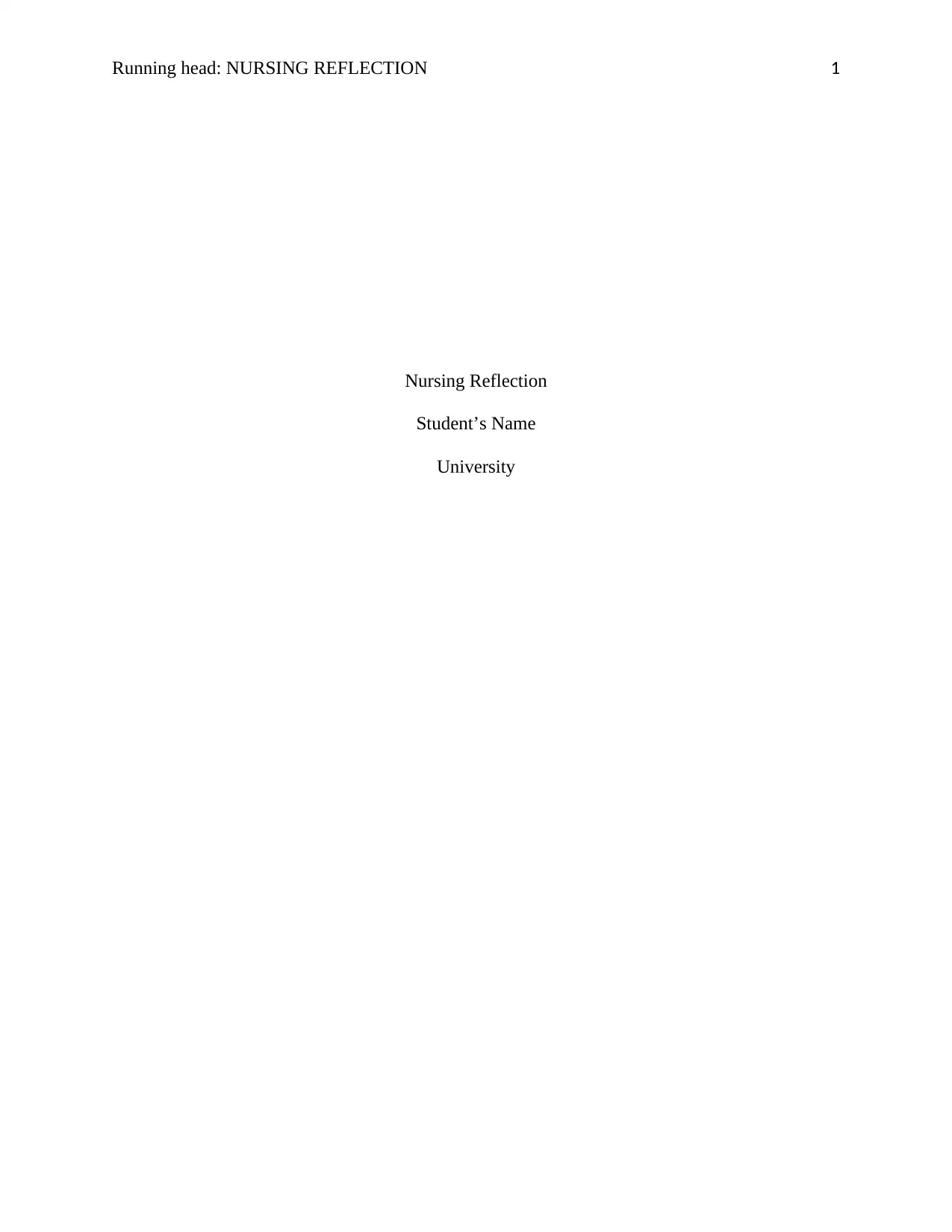
Running head: NURSING REFLECTION 1
Nursing Reflection
Student’s Name
University
Nursing Reflection
Student’s Name
University
Paraphrase This Document
Need a fresh take? Get an instant paraphrase of this document with our AI Paraphraser
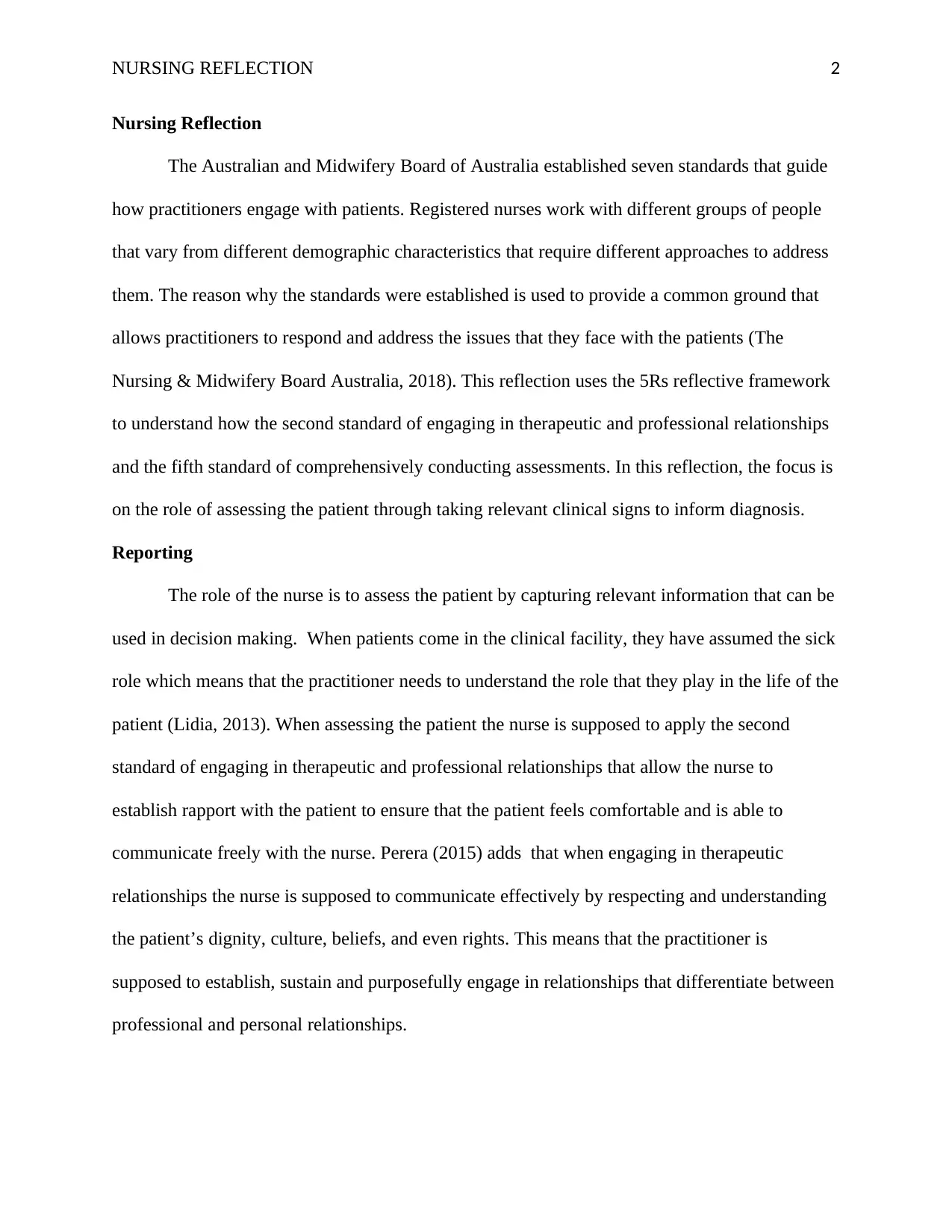
NURSING REFLECTION 2
Nursing Reflection
The Australian and Midwifery Board of Australia established seven standards that guide
how practitioners engage with patients. Registered nurses work with different groups of people
that vary from different demographic characteristics that require different approaches to address
them. The reason why the standards were established is used to provide a common ground that
allows practitioners to respond and address the issues that they face with the patients (The
Nursing & Midwifery Board Australia, 2018). This reflection uses the 5Rs reflective framework
to understand how the second standard of engaging in therapeutic and professional relationships
and the fifth standard of comprehensively conducting assessments. In this reflection, the focus is
on the role of assessing the patient through taking relevant clinical signs to inform diagnosis.
Reporting
The role of the nurse is to assess the patient by capturing relevant information that can be
used in decision making. When patients come in the clinical facility, they have assumed the sick
role which means that the practitioner needs to understand the role that they play in the life of the
patient (Lidia, 2013). When assessing the patient the nurse is supposed to apply the second
standard of engaging in therapeutic and professional relationships that allow the nurse to
establish rapport with the patient to ensure that the patient feels comfortable and is able to
communicate freely with the nurse. Perera (2015) adds that when engaging in therapeutic
relationships the nurse is supposed to communicate effectively by respecting and understanding
the patient’s dignity, culture, beliefs, and even rights. This means that the practitioner is
supposed to establish, sustain and purposefully engage in relationships that differentiate between
professional and personal relationships.
Nursing Reflection
The Australian and Midwifery Board of Australia established seven standards that guide
how practitioners engage with patients. Registered nurses work with different groups of people
that vary from different demographic characteristics that require different approaches to address
them. The reason why the standards were established is used to provide a common ground that
allows practitioners to respond and address the issues that they face with the patients (The
Nursing & Midwifery Board Australia, 2018). This reflection uses the 5Rs reflective framework
to understand how the second standard of engaging in therapeutic and professional relationships
and the fifth standard of comprehensively conducting assessments. In this reflection, the focus is
on the role of assessing the patient through taking relevant clinical signs to inform diagnosis.
Reporting
The role of the nurse is to assess the patient by capturing relevant information that can be
used in decision making. When patients come in the clinical facility, they have assumed the sick
role which means that the practitioner needs to understand the role that they play in the life of the
patient (Lidia, 2013). When assessing the patient the nurse is supposed to apply the second
standard of engaging in therapeutic and professional relationships that allow the nurse to
establish rapport with the patient to ensure that the patient feels comfortable and is able to
communicate freely with the nurse. Perera (2015) adds that when engaging in therapeutic
relationships the nurse is supposed to communicate effectively by respecting and understanding
the patient’s dignity, culture, beliefs, and even rights. This means that the practitioner is
supposed to establish, sustain and purposefully engage in relationships that differentiate between
professional and personal relationships.
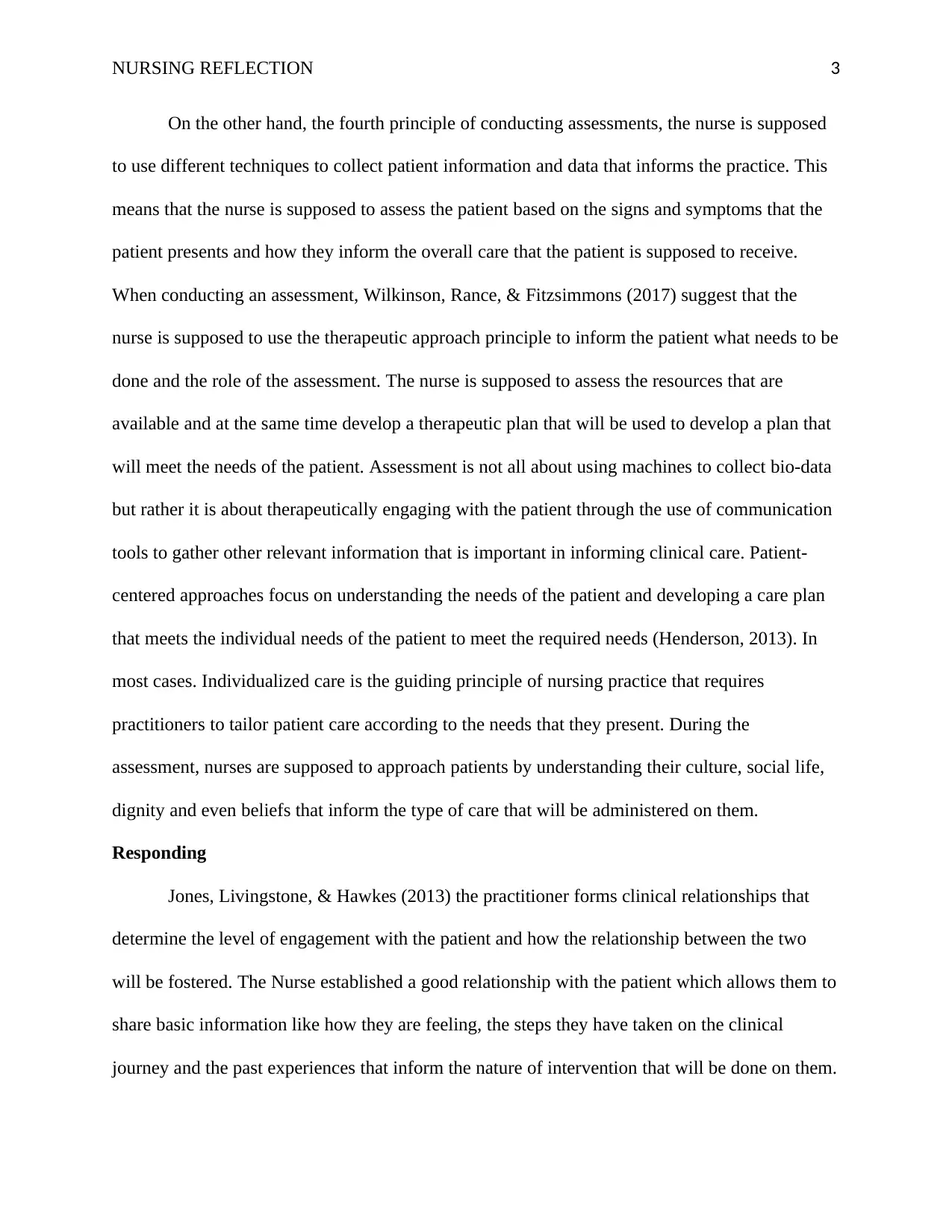
NURSING REFLECTION 3
On the other hand, the fourth principle of conducting assessments, the nurse is supposed
to use different techniques to collect patient information and data that informs the practice. This
means that the nurse is supposed to assess the patient based on the signs and symptoms that the
patient presents and how they inform the overall care that the patient is supposed to receive.
When conducting an assessment, Wilkinson, Rance, & Fitzsimmons (2017) suggest that the
nurse is supposed to use the therapeutic approach principle to inform the patient what needs to be
done and the role of the assessment. The nurse is supposed to assess the resources that are
available and at the same time develop a therapeutic plan that will be used to develop a plan that
will meet the needs of the patient. Assessment is not all about using machines to collect bio-data
but rather it is about therapeutically engaging with the patient through the use of communication
tools to gather other relevant information that is important in informing clinical care. Patient-
centered approaches focus on understanding the needs of the patient and developing a care plan
that meets the individual needs of the patient to meet the required needs (Henderson, 2013). In
most cases. Individualized care is the guiding principle of nursing practice that requires
practitioners to tailor patient care according to the needs that they present. During the
assessment, nurses are supposed to approach patients by understanding their culture, social life,
dignity and even beliefs that inform the type of care that will be administered on them.
Responding
Jones, Livingstone, & Hawkes (2013) the practitioner forms clinical relationships that
determine the level of engagement with the patient and how the relationship between the two
will be fostered. The Nurse established a good relationship with the patient which allows them to
share basic information like how they are feeling, the steps they have taken on the clinical
journey and the past experiences that inform the nature of intervention that will be done on them.
On the other hand, the fourth principle of conducting assessments, the nurse is supposed
to use different techniques to collect patient information and data that informs the practice. This
means that the nurse is supposed to assess the patient based on the signs and symptoms that the
patient presents and how they inform the overall care that the patient is supposed to receive.
When conducting an assessment, Wilkinson, Rance, & Fitzsimmons (2017) suggest that the
nurse is supposed to use the therapeutic approach principle to inform the patient what needs to be
done and the role of the assessment. The nurse is supposed to assess the resources that are
available and at the same time develop a therapeutic plan that will be used to develop a plan that
will meet the needs of the patient. Assessment is not all about using machines to collect bio-data
but rather it is about therapeutically engaging with the patient through the use of communication
tools to gather other relevant information that is important in informing clinical care. Patient-
centered approaches focus on understanding the needs of the patient and developing a care plan
that meets the individual needs of the patient to meet the required needs (Henderson, 2013). In
most cases. Individualized care is the guiding principle of nursing practice that requires
practitioners to tailor patient care according to the needs that they present. During the
assessment, nurses are supposed to approach patients by understanding their culture, social life,
dignity and even beliefs that inform the type of care that will be administered on them.
Responding
Jones, Livingstone, & Hawkes (2013) the practitioner forms clinical relationships that
determine the level of engagement with the patient and how the relationship between the two
will be fostered. The Nurse established a good relationship with the patient which allows them to
share basic information like how they are feeling, the steps they have taken on the clinical
journey and the past experiences that inform the nature of intervention that will be done on them.
⊘ This is a preview!⊘
Do you want full access?
Subscribe today to unlock all pages.

Trusted by 1+ million students worldwide
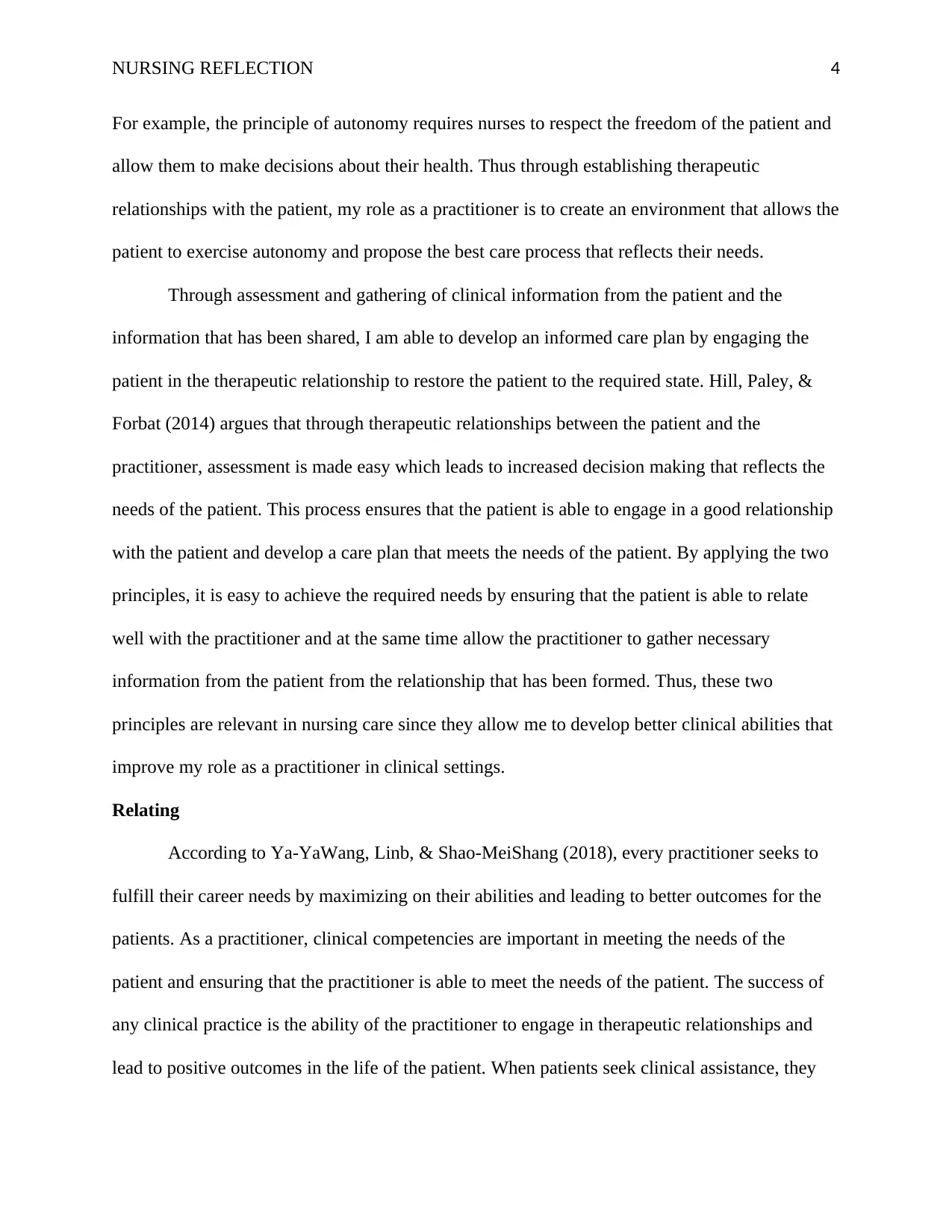
NURSING REFLECTION 4
For example, the principle of autonomy requires nurses to respect the freedom of the patient and
allow them to make decisions about their health. Thus through establishing therapeutic
relationships with the patient, my role as a practitioner is to create an environment that allows the
patient to exercise autonomy and propose the best care process that reflects their needs.
Through assessment and gathering of clinical information from the patient and the
information that has been shared, I am able to develop an informed care plan by engaging the
patient in the therapeutic relationship to restore the patient to the required state. Hill, Paley, &
Forbat (2014) argues that through therapeutic relationships between the patient and the
practitioner, assessment is made easy which leads to increased decision making that reflects the
needs of the patient. This process ensures that the patient is able to engage in a good relationship
with the patient and develop a care plan that meets the needs of the patient. By applying the two
principles, it is easy to achieve the required needs by ensuring that the patient is able to relate
well with the practitioner and at the same time allow the practitioner to gather necessary
information from the patient from the relationship that has been formed. Thus, these two
principles are relevant in nursing care since they allow me to develop better clinical abilities that
improve my role as a practitioner in clinical settings.
Relating
According to Ya-YaWang, Linb, & Shao-MeiShang (2018), every practitioner seeks to
fulfill their career needs by maximizing on their abilities and leading to better outcomes for the
patients. As a practitioner, clinical competencies are important in meeting the needs of the
patient and ensuring that the practitioner is able to meet the needs of the patient. The success of
any clinical practice is the ability of the practitioner to engage in therapeutic relationships and
lead to positive outcomes in the life of the patient. When patients seek clinical assistance, they
For example, the principle of autonomy requires nurses to respect the freedom of the patient and
allow them to make decisions about their health. Thus through establishing therapeutic
relationships with the patient, my role as a practitioner is to create an environment that allows the
patient to exercise autonomy and propose the best care process that reflects their needs.
Through assessment and gathering of clinical information from the patient and the
information that has been shared, I am able to develop an informed care plan by engaging the
patient in the therapeutic relationship to restore the patient to the required state. Hill, Paley, &
Forbat (2014) argues that through therapeutic relationships between the patient and the
practitioner, assessment is made easy which leads to increased decision making that reflects the
needs of the patient. This process ensures that the patient is able to engage in a good relationship
with the patient and develop a care plan that meets the needs of the patient. By applying the two
principles, it is easy to achieve the required needs by ensuring that the patient is able to relate
well with the practitioner and at the same time allow the practitioner to gather necessary
information from the patient from the relationship that has been formed. Thus, these two
principles are relevant in nursing care since they allow me to develop better clinical abilities that
improve my role as a practitioner in clinical settings.
Relating
According to Ya-YaWang, Linb, & Shao-MeiShang (2018), every practitioner seeks to
fulfill their career needs by maximizing on their abilities and leading to better outcomes for the
patients. As a practitioner, clinical competencies are important in meeting the needs of the
patient and ensuring that the practitioner is able to meet the needs of the patient. The success of
any clinical practice is the ability of the practitioner to engage in therapeutic relationships and
lead to positive outcomes in the life of the patient. When patients seek clinical assistance, they
Paraphrase This Document
Need a fresh take? Get an instant paraphrase of this document with our AI Paraphraser
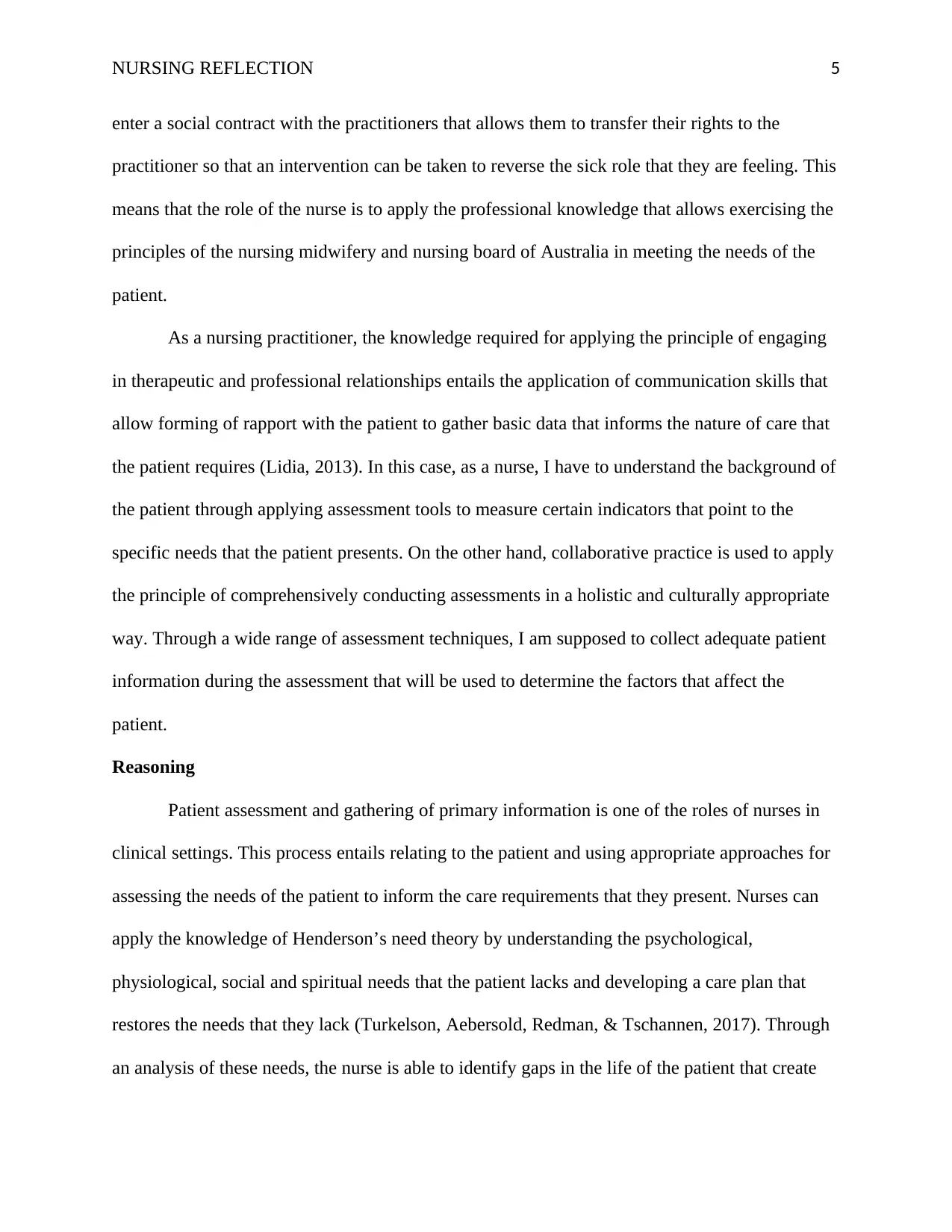
NURSING REFLECTION 5
enter a social contract with the practitioners that allows them to transfer their rights to the
practitioner so that an intervention can be taken to reverse the sick role that they are feeling. This
means that the role of the nurse is to apply the professional knowledge that allows exercising the
principles of the nursing midwifery and nursing board of Australia in meeting the needs of the
patient.
As a nursing practitioner, the knowledge required for applying the principle of engaging
in therapeutic and professional relationships entails the application of communication skills that
allow forming of rapport with the patient to gather basic data that informs the nature of care that
the patient requires (Lidia, 2013). In this case, as a nurse, I have to understand the background of
the patient through applying assessment tools to measure certain indicators that point to the
specific needs that the patient presents. On the other hand, collaborative practice is used to apply
the principle of comprehensively conducting assessments in a holistic and culturally appropriate
way. Through a wide range of assessment techniques, I am supposed to collect adequate patient
information during the assessment that will be used to determine the factors that affect the
patient.
Reasoning
Patient assessment and gathering of primary information is one of the roles of nurses in
clinical settings. This process entails relating to the patient and using appropriate approaches for
assessing the needs of the patient to inform the care requirements that they present. Nurses can
apply the knowledge of Henderson’s need theory by understanding the psychological,
physiological, social and spiritual needs that the patient lacks and developing a care plan that
restores the needs that they lack (Turkelson, Aebersold, Redman, & Tschannen, 2017). Through
an analysis of these needs, the nurse is able to identify gaps in the life of the patient that create
enter a social contract with the practitioners that allows them to transfer their rights to the
practitioner so that an intervention can be taken to reverse the sick role that they are feeling. This
means that the role of the nurse is to apply the professional knowledge that allows exercising the
principles of the nursing midwifery and nursing board of Australia in meeting the needs of the
patient.
As a nursing practitioner, the knowledge required for applying the principle of engaging
in therapeutic and professional relationships entails the application of communication skills that
allow forming of rapport with the patient to gather basic data that informs the nature of care that
the patient requires (Lidia, 2013). In this case, as a nurse, I have to understand the background of
the patient through applying assessment tools to measure certain indicators that point to the
specific needs that the patient presents. On the other hand, collaborative practice is used to apply
the principle of comprehensively conducting assessments in a holistic and culturally appropriate
way. Through a wide range of assessment techniques, I am supposed to collect adequate patient
information during the assessment that will be used to determine the factors that affect the
patient.
Reasoning
Patient assessment and gathering of primary information is one of the roles of nurses in
clinical settings. This process entails relating to the patient and using appropriate approaches for
assessing the needs of the patient to inform the care requirements that they present. Nurses can
apply the knowledge of Henderson’s need theory by understanding the psychological,
physiological, social and spiritual needs that the patient lacks and developing a care plan that
restores the needs that they lack (Turkelson, Aebersold, Redman, & Tschannen, 2017). Through
an analysis of these needs, the nurse is able to identify gaps in the life of the patient that create
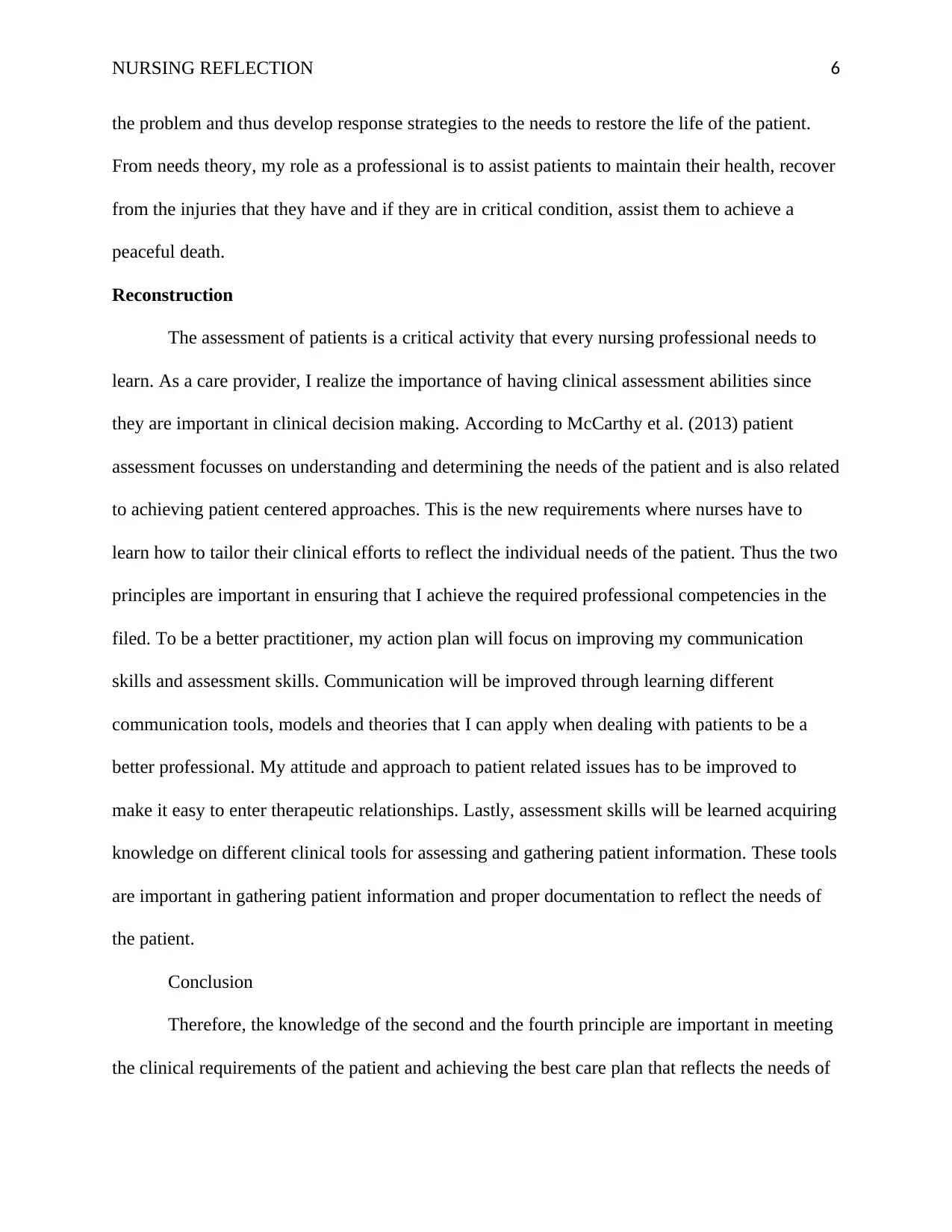
NURSING REFLECTION 6
the problem and thus develop response strategies to the needs to restore the life of the patient.
From needs theory, my role as a professional is to assist patients to maintain their health, recover
from the injuries that they have and if they are in critical condition, assist them to achieve a
peaceful death.
Reconstruction
The assessment of patients is a critical activity that every nursing professional needs to
learn. As a care provider, I realize the importance of having clinical assessment abilities since
they are important in clinical decision making. According to McCarthy et al. (2013) patient
assessment focusses on understanding and determining the needs of the patient and is also related
to achieving patient centered approaches. This is the new requirements where nurses have to
learn how to tailor their clinical efforts to reflect the individual needs of the patient. Thus the two
principles are important in ensuring that I achieve the required professional competencies in the
filed. To be a better practitioner, my action plan will focus on improving my communication
skills and assessment skills. Communication will be improved through learning different
communication tools, models and theories that I can apply when dealing with patients to be a
better professional. My attitude and approach to patient related issues has to be improved to
make it easy to enter therapeutic relationships. Lastly, assessment skills will be learned acquiring
knowledge on different clinical tools for assessing and gathering patient information. These tools
are important in gathering patient information and proper documentation to reflect the needs of
the patient.
Conclusion
Therefore, the knowledge of the second and the fourth principle are important in meeting
the clinical requirements of the patient and achieving the best care plan that reflects the needs of
the problem and thus develop response strategies to the needs to restore the life of the patient.
From needs theory, my role as a professional is to assist patients to maintain their health, recover
from the injuries that they have and if they are in critical condition, assist them to achieve a
peaceful death.
Reconstruction
The assessment of patients is a critical activity that every nursing professional needs to
learn. As a care provider, I realize the importance of having clinical assessment abilities since
they are important in clinical decision making. According to McCarthy et al. (2013) patient
assessment focusses on understanding and determining the needs of the patient and is also related
to achieving patient centered approaches. This is the new requirements where nurses have to
learn how to tailor their clinical efforts to reflect the individual needs of the patient. Thus the two
principles are important in ensuring that I achieve the required professional competencies in the
filed. To be a better practitioner, my action plan will focus on improving my communication
skills and assessment skills. Communication will be improved through learning different
communication tools, models and theories that I can apply when dealing with patients to be a
better professional. My attitude and approach to patient related issues has to be improved to
make it easy to enter therapeutic relationships. Lastly, assessment skills will be learned acquiring
knowledge on different clinical tools for assessing and gathering patient information. These tools
are important in gathering patient information and proper documentation to reflect the needs of
the patient.
Conclusion
Therefore, the knowledge of the second and the fourth principle are important in meeting
the clinical requirements of the patient and achieving the best care plan that reflects the needs of
⊘ This is a preview!⊘
Do you want full access?
Subscribe today to unlock all pages.

Trusted by 1+ million students worldwide
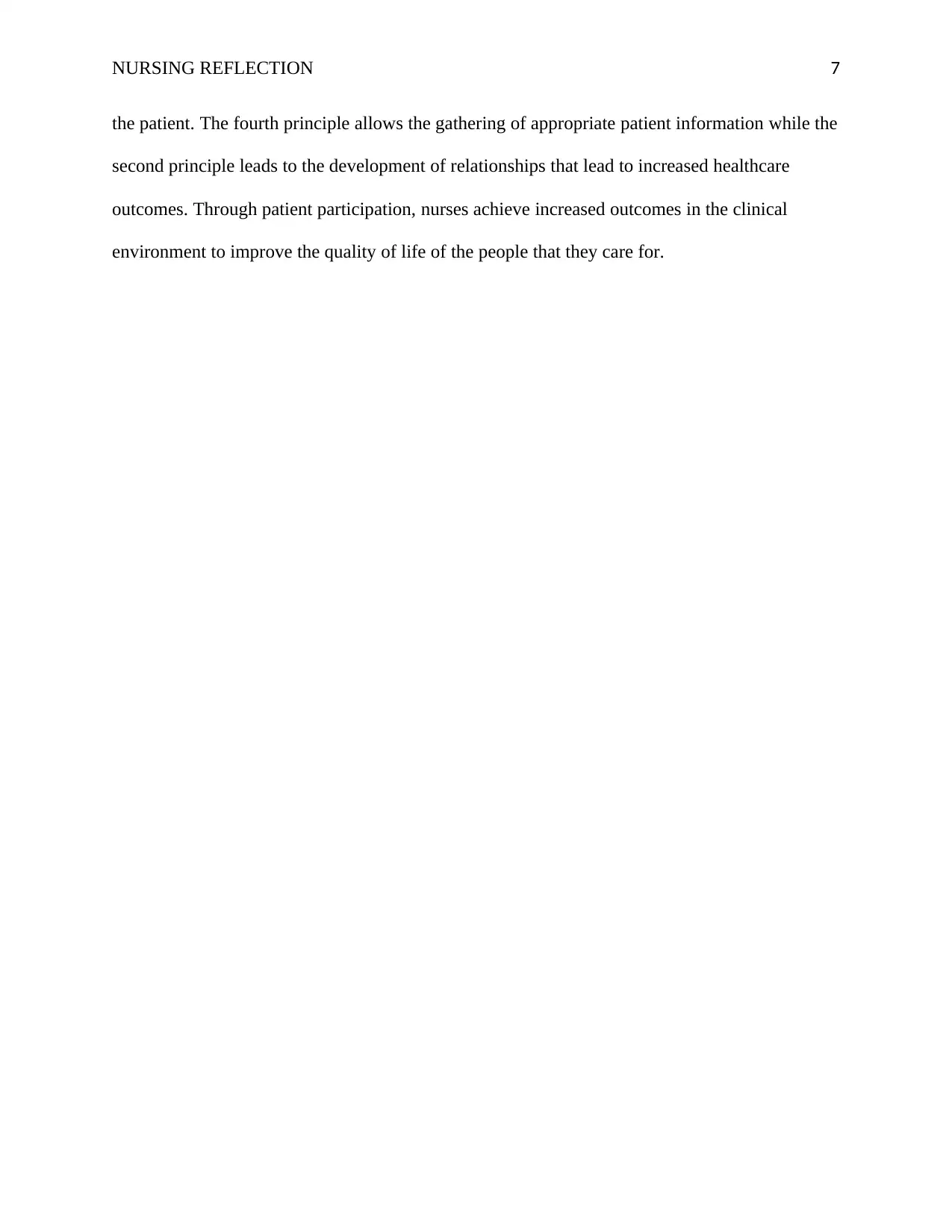
NURSING REFLECTION 7
the patient. The fourth principle allows the gathering of appropriate patient information while the
second principle leads to the development of relationships that lead to increased healthcare
outcomes. Through patient participation, nurses achieve increased outcomes in the clinical
environment to improve the quality of life of the people that they care for.
the patient. The fourth principle allows the gathering of appropriate patient information while the
second principle leads to the development of relationships that lead to increased healthcare
outcomes. Through patient participation, nurses achieve increased outcomes in the clinical
environment to improve the quality of life of the people that they care for.
Paraphrase This Document
Need a fresh take? Get an instant paraphrase of this document with our AI Paraphraser
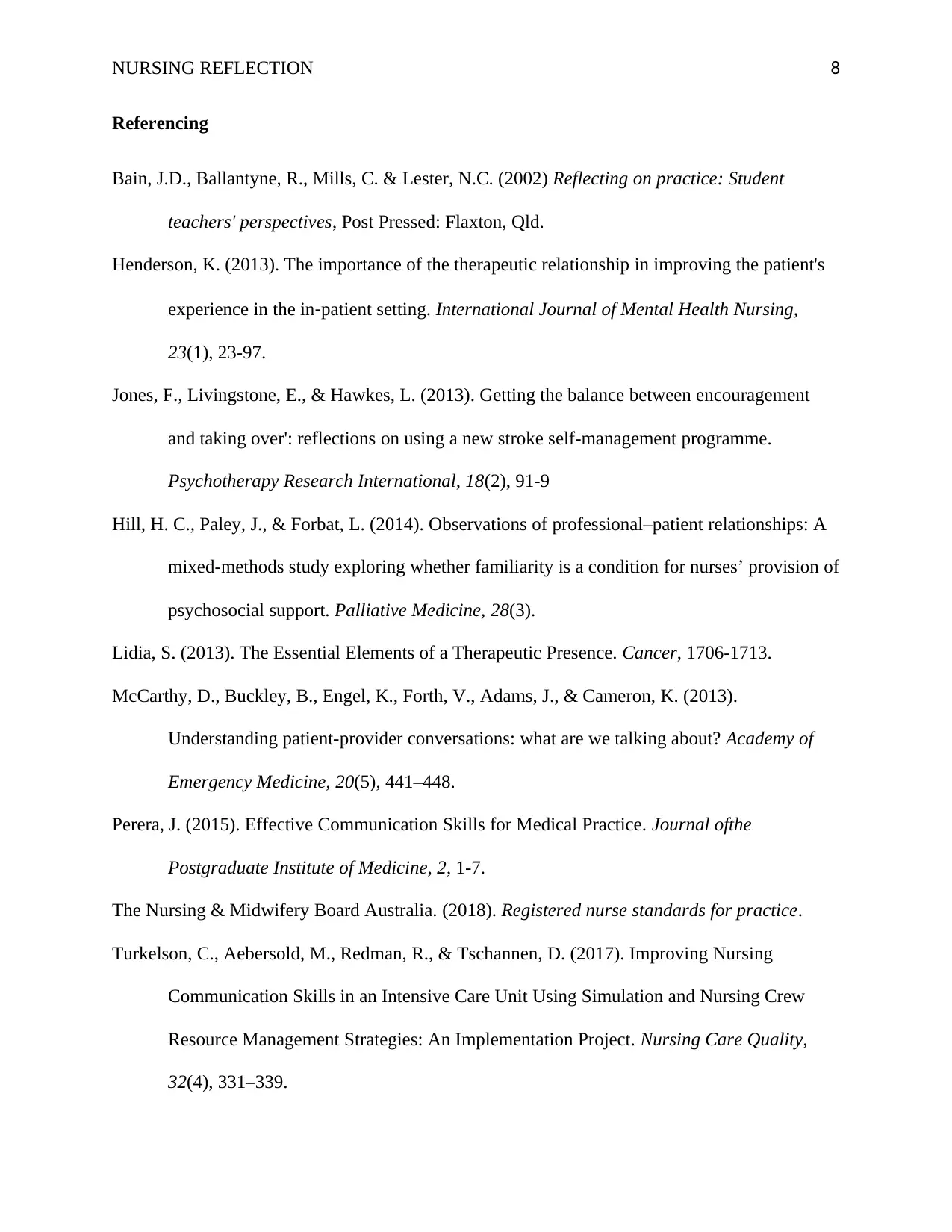
NURSING REFLECTION 8
Referencing
Bain, J.D., Ballantyne, R., Mills, C. & Lester, N.C. (2002) Reflecting on practice: Student
teachers' perspectives, Post Pressed: Flaxton, Qld.
Henderson, K. (2013). The importance of the therapeutic relationship in improving the patient's
experience in the in‐patient setting. International Journal of Mental Health Nursing,
23(1), 23-97.
Jones, F., Livingstone, E., & Hawkes, L. (2013). Getting the balance between encouragement
and taking over': reflections on using a new stroke self-management programme.
Psychotherapy Research International, 18(2), 91-9
Hill, H. C., Paley, J., & Forbat, L. (2014). Observations of professional–patient relationships: A
mixed-methods study exploring whether familiarity is a condition for nurses’ provision of
psychosocial support. Palliative Medicine, 28(3).
Lidia, S. (2013). The Essential Elements of a Therapeutic Presence. Cancer, 1706-1713.
McCarthy, D., Buckley, B., Engel, K., Forth, V., Adams, J., & Cameron, K. (2013).
Understanding patient-provider conversations: what are we talking about? Academy of
Emergency Medicine, 20(5), 441–448.
Perera, J. (2015). Effective Communication Skills for Medical Practice. Journal ofthe
Postgraduate Institute of Medicine, 2, 1-7.
The Nursing & Midwifery Board Australia. (2018). Registered nurse standards for practice.
Turkelson, C., Aebersold, M., Redman, R., & Tschannen, D. (2017). Improving Nursing
Communication Skills in an Intensive Care Unit Using Simulation and Nursing Crew
Resource Management Strategies: An Implementation Project. Nursing Care Quality,
32(4), 331–339.
Referencing
Bain, J.D., Ballantyne, R., Mills, C. & Lester, N.C. (2002) Reflecting on practice: Student
teachers' perspectives, Post Pressed: Flaxton, Qld.
Henderson, K. (2013). The importance of the therapeutic relationship in improving the patient's
experience in the in‐patient setting. International Journal of Mental Health Nursing,
23(1), 23-97.
Jones, F., Livingstone, E., & Hawkes, L. (2013). Getting the balance between encouragement
and taking over': reflections on using a new stroke self-management programme.
Psychotherapy Research International, 18(2), 91-9
Hill, H. C., Paley, J., & Forbat, L. (2014). Observations of professional–patient relationships: A
mixed-methods study exploring whether familiarity is a condition for nurses’ provision of
psychosocial support. Palliative Medicine, 28(3).
Lidia, S. (2013). The Essential Elements of a Therapeutic Presence. Cancer, 1706-1713.
McCarthy, D., Buckley, B., Engel, K., Forth, V., Adams, J., & Cameron, K. (2013).
Understanding patient-provider conversations: what are we talking about? Academy of
Emergency Medicine, 20(5), 441–448.
Perera, J. (2015). Effective Communication Skills for Medical Practice. Journal ofthe
Postgraduate Institute of Medicine, 2, 1-7.
The Nursing & Midwifery Board Australia. (2018). Registered nurse standards for practice.
Turkelson, C., Aebersold, M., Redman, R., & Tschannen, D. (2017). Improving Nursing
Communication Skills in an Intensive Care Unit Using Simulation and Nursing Crew
Resource Management Strategies: An Implementation Project. Nursing Care Quality,
32(4), 331–339.
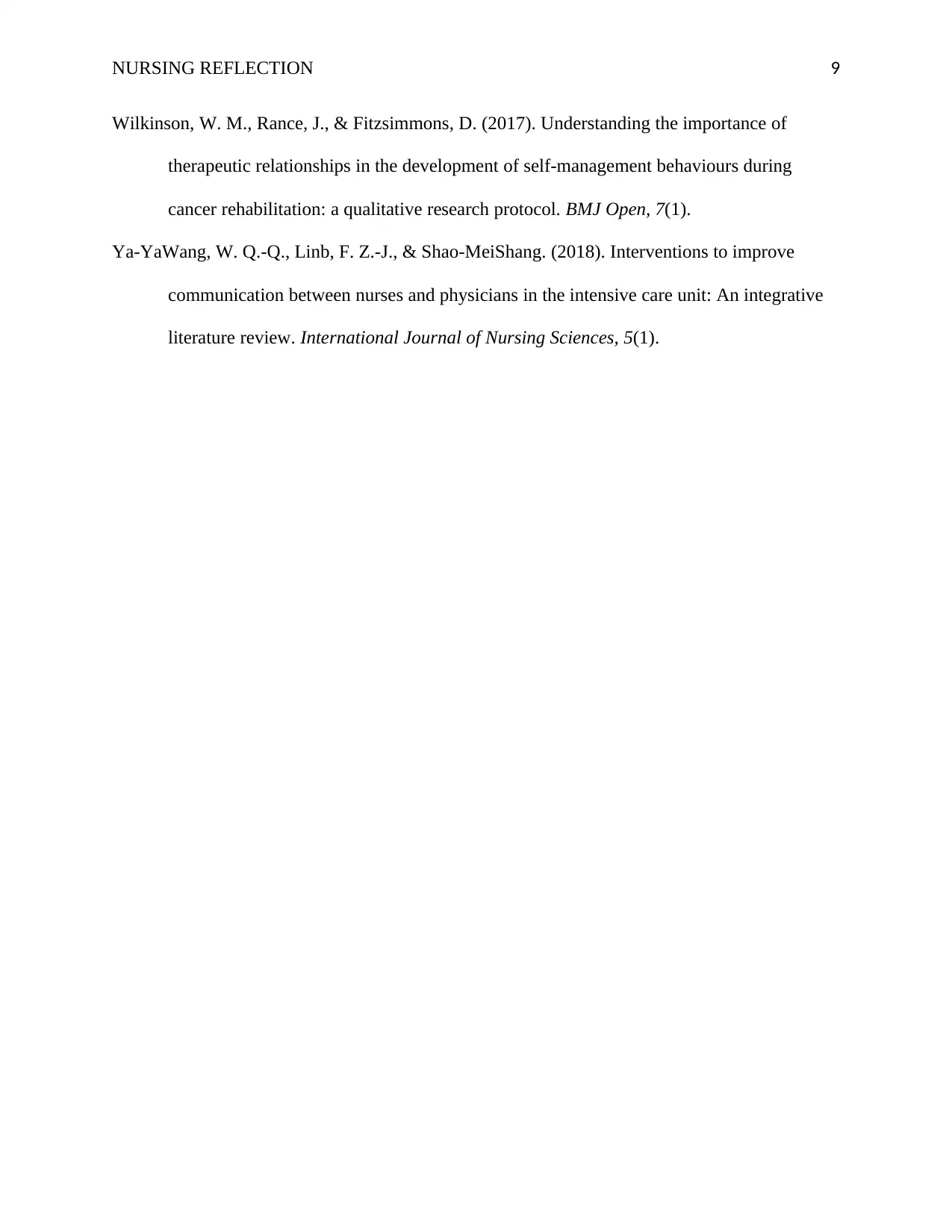
NURSING REFLECTION 9
Wilkinson, W. M., Rance, J., & Fitzsimmons, D. (2017). Understanding the importance of
therapeutic relationships in the development of self-management behaviours during
cancer rehabilitation: a qualitative research protocol. BMJ Open, 7(1).
Ya-YaWang, W. Q.-Q., Linb, F. Z.-J., & Shao-MeiShang. (2018). Interventions to improve
communication between nurses and physicians in the intensive care unit: An integrative
literature review. International Journal of Nursing Sciences, 5(1).
Wilkinson, W. M., Rance, J., & Fitzsimmons, D. (2017). Understanding the importance of
therapeutic relationships in the development of self-management behaviours during
cancer rehabilitation: a qualitative research protocol. BMJ Open, 7(1).
Ya-YaWang, W. Q.-Q., Linb, F. Z.-J., & Shao-MeiShang. (2018). Interventions to improve
communication between nurses and physicians in the intensive care unit: An integrative
literature review. International Journal of Nursing Sciences, 5(1).
⊘ This is a preview!⊘
Do you want full access?
Subscribe today to unlock all pages.

Trusted by 1+ million students worldwide
1 out of 9
Related Documents
Your All-in-One AI-Powered Toolkit for Academic Success.
+13062052269
info@desklib.com
Available 24*7 on WhatsApp / Email
![[object Object]](/_next/static/media/star-bottom.7253800d.svg)
Unlock your academic potential
Copyright © 2020–2025 A2Z Services. All Rights Reserved. Developed and managed by ZUCOL.


